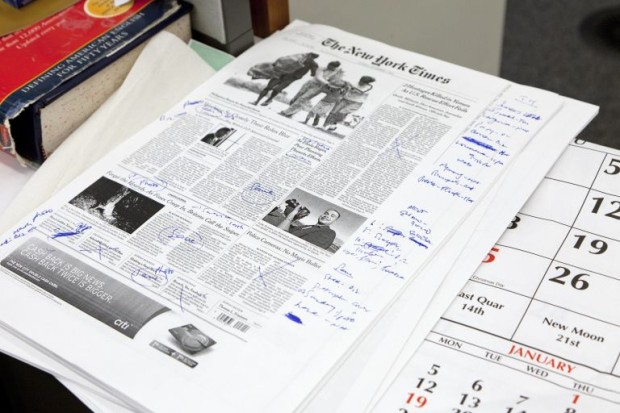
In a fascinating piece for Popular Mechanics, Reeves Wiedeman looks at how the New York Times gets made in 2015. It’s interesting how their graphics department has evolved in the past few years:
The Times employs approximately 1,300 journalists, a classification that now includes much more than writers, editors, and photographers. There are videographers and developer–journalists and graphic designers, who insist that you not call them graphic designers. Every section of the paper has been affected by the Internet, but the graphics department is hardly recognizable from the days not long ago when, to accompany a story about Borneo, for example, it would simply produce a small black-and-white map of Borneo. [Graphics editor] Duenes’s desk still produces traditional newspaper graphics, but it also now employs thirty-five people who have expertise in statistics, programming, cartography, 3D modeling, motion graphics, audio production, or video editing. At the department’s two long desks, designer Haeyoun Park combs through data on the racial breakdown of police forces—a story the graphics team reported without any instigation from print reporters—while nearby Matt Bloch is updating the paper’s digital hurricane tracker… A breaking-news event might require eight members of Duenes’s team, who are otherwise free to focus on the kind of in-depth reporting for which the Times‘ print reporters are generally known. Last August a graphics editor who had been tracking police data for four years discovered that the New York Police Department had more or less ended its controversial stop-and-frisk policy, which some critics had described as racial profiling. This was news to the reporters on the Metro desk, and the editor there assigned a story to go along with the graphics department’s analysis.
The story, and the graphic, ran on the front page.
I also particularly liked the stuff about their R & D Lab:
1 CommentThe R&D Lab opened nine years ago with the goal of looking three to five years into the future. (TheTimes declined to say how much it cost to build.) Marc Frons, the company’s CIO says he has no idea how people will interact with theTimes in ten years, “whether it’s on your wrist, or your forehead, or you take a pill, or it’s a holographic contact lens, or a head-up display in your vehicle—or on your mirror in your bathroom.” The lab explored E Ink before the Kindle even existed, was responsible for delivering the earliest versions of the paper’s mobile news alerts, and helped the Times become the first publisher with an application on Google Glass. One of the lab’s researchers recently designed a brooch programmed to light up whenever a topic is mentioned that matches something the wearer read about online that day. What good would that do, exactly? Boggie answers with enthusiasm, “We don’t know yet!”



